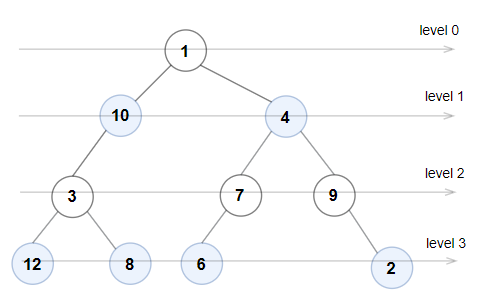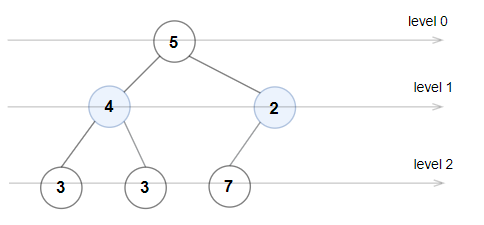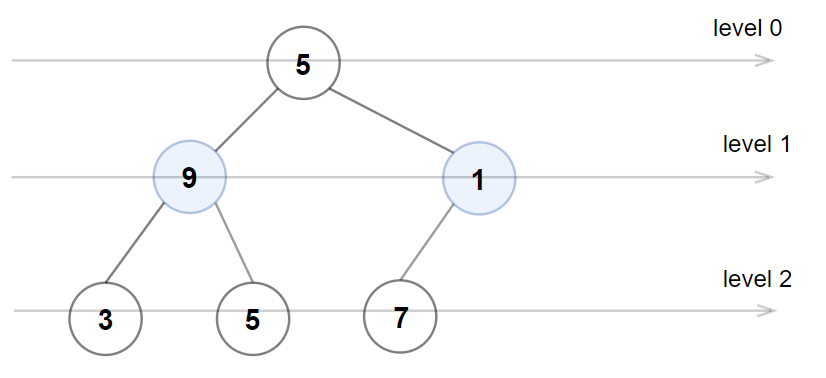Description
A binary tree is named Even-Odd if it meets the following conditions:
- The root of the binary tree is at level index
0, its children are at level index1, their children are at level index2, etc. - For every even-indexed level, all nodes at the level have odd integer values in strictly increasing order (from left to right).
- For every odd-indexed level, all nodes at the level have even integer values in strictly decreasing order (from left to right).
Given the root of a binary tree, return true if the binary tree is Even-Odd, otherwise return false.
Example 1:

Input: root = [1,10,4,3,null,7,9,12,8,6,null,null,2] Output: true Explanation: The node values on each level are: Level 0: [1] Level 1: [10,4] Level 2: [3,7,9] Level 3: [12,8,6,2] Since levels 0 and 2 are all odd and increasing and levels 1 and 3 are all even and decreasing, the tree is Even-Odd.
Example 2:

Input: root = [5,4,2,3,3,7] Output: false Explanation: The node values on each level are: Level 0: [5] Level 1: [4,2] Level 2: [3,3,7] Node values in level 2 must be in strictly increasing order, so the tree is not Even-Odd.
Example 3:

Input: root = [5,9,1,3,5,7] Output: false Explanation: Node values in the level 1 should be even integers.
Constraints:
- The number of nodes in the tree is in the range
[1, 105]. 1 <= Node.val <= 106
Code
Time Complexity: , Space Complexity:
使用 Binary Tree Level Order Traversal 就行了。
/**
* Definition for a binary tree node.
* struct TreeNode {
* int val;
* TreeNode *left;
* TreeNode *right;
* TreeNode() : val(0), left(nullptr), right(nullptr) {}
* TreeNode(int x) : val(x), left(nullptr), right(nullptr) {}
* TreeNode(int x, TreeNode *left, TreeNode *right) : val(x), left(left), right(right) {}
* };
*/
class Solution {
public:
bool isEvenOddTree(TreeNode* root) {
queue<TreeNode*> q;
q.push(root);
int level = 0;
while(!q.empty()) {
int n = q.size();
int prev = level % 2 == 0 ? 0 : 1e6 + 1;
for(int i = 0; i < n; i++) {
bool increasing = level % 2 == 0 ? true : false;
auto node = q.front();
q.pop();
if(increasing) {
if(node->val % 2 == 0)
return false;
else {
if(node->val <= prev)
return false;
}
} else {
if(node->val % 2 != 0)
return false;
else {
if(node->val >= prev)
return false;
}
}
prev = node->val;
if(node->left) q.push(node->left);
if(node->right) q.push(node->right);
}
level++;
}
return true;
}
};